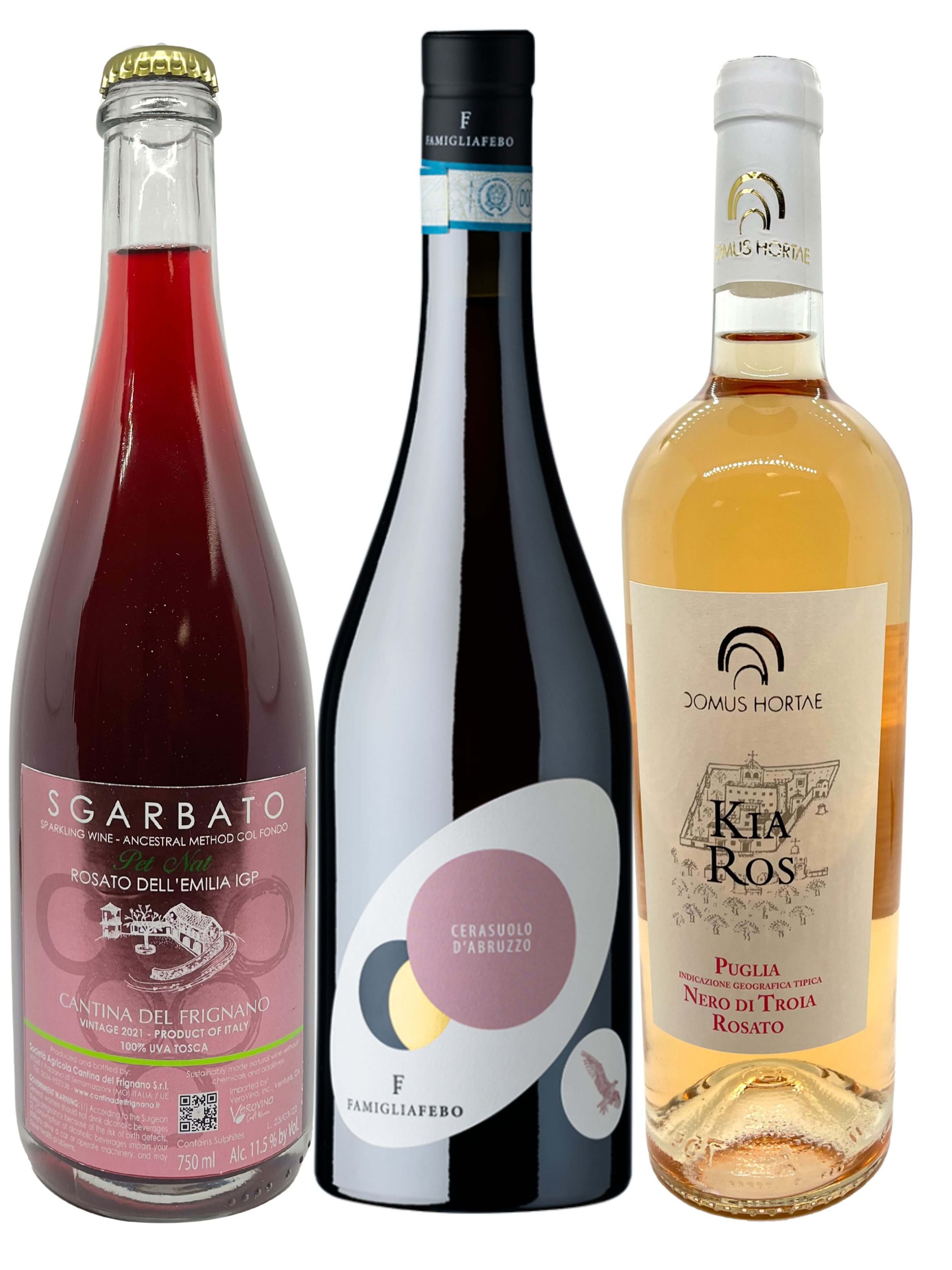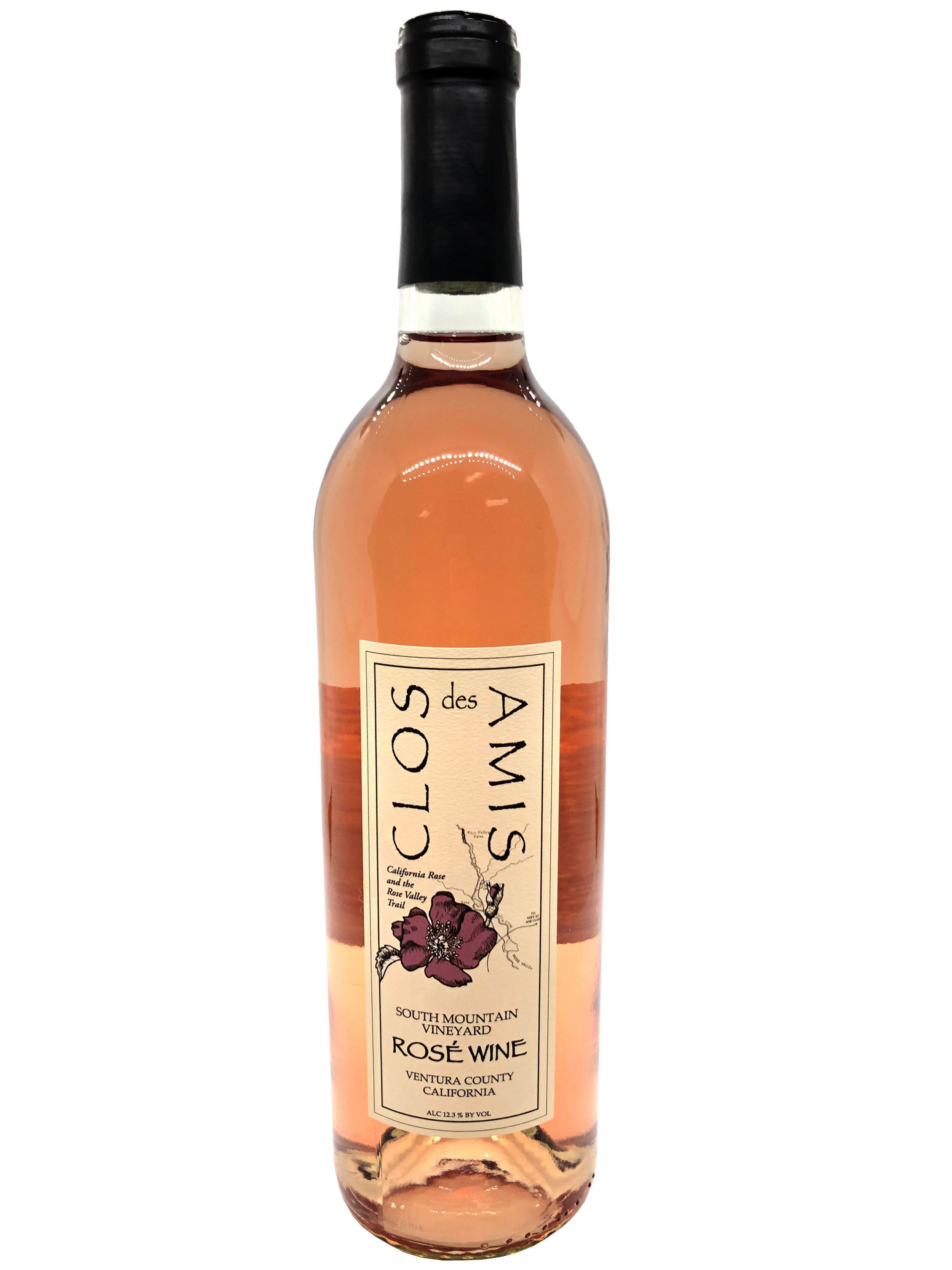The Scoop on Rosé
“I pick grapes early for the correct components to create a bright, fresh rosé wine,” says Bruce Freeman, grape grower and winemaker at Clos Des Amis in Santa Paula. “I press them immediately, bottle them early, and capture that liveliness that makes a rosé so fun to drink."
What Bruce is describing is intentional rosé winemaking: a wine made from vines grown to make rosé, picked to make rosé, pressed to make rosé, and vinified to make rosé.
Winemaker Bruce Freeman oversees the bottling machine during the Rosé 2020 bottling.
How is Rosé Made?
What Grapes Are in Rosé?
While making rosé may seem as simple as blending white wine with red to make pink, that is rarely the case, although sometimes a winemaker will add a touch of a red wine to a rosé to get the desired color.
First, rosé wine is made from red grapes. Since the color in wine comes from contact between the skins and the juice, the grapes are pressed and the skins quickly separated from the juice so little to no color is imparted.
Second, there's two primary methods, the intentional one described above by winemaker Bruce Freeman, and the saignée method where a rosé wine is made from grapes grown to make a red wine and then, in order to intensify the character of the red wine, some of the juice is pressed off and made into a rosé. The rest of the juice has more contact with the skins to make a redder wine.
Saignée is popular with lighter hued grapes like Pinot Noir and makes a delicious wine, however, intentionally made rosé is another beverage entirely than saignée which is really a process to make a better red wine -- not a method to make the best pink wine possible.
Rosé can be made from one grape variety or a blend of several. For winemakers, it can be more challenging to achieve a balanced rosé as a monovarietal than as a blended one. Because of regional style, history, and law, Provençal rosés are blended, and they may even co-press white grapes with the red. For the Clos des Amis 2020 rosé wine, Grenache and Mourvedre were picked at the same time, crushed together, and vinified together as a field blend of about 50% of each grape.
A rosé of Pinot Noir, Zinfandel or Sangiovese or a blended rosé from Provence are all very different wines. There's a lot of excitement in the wine world about less traditional red grapes made into rosé, especially the potential for indigenous varieties like uva tosca as a rosé. In fact, we carry a rosè made with uva tosca, a Rosè Pet Nat Lambrusco Sparkling Wine from Emilia Romagna, nearby Bologna.
How Should I Serve Rosé?
Some winemakers make their rosé to be thirst quenchers consumed cold while other rosé wines pair better with food at cellar temperature (50-60 degrees F). There's something to be said for the rosé all day idea because rosé works from brunch through lunch (especially picnics or working lunches because it is typically low in a alcohol!) For dinner, rosé pairs wonderfully with pork and fowl. While you can serve it icy cold, often it is better at cellar temperature — somewhere in the 50s or 60s — making it ideal for outdoor dining because it's enjoyable as it warms up to the ambient temperature.
While there are fancy rosé glasses, you can experiment with the glasses you already own. Consider tulip shaped pinot grigio glasses as well as pinot noir glasses — particularly for rosé of pinot noir! Think about putting a rosé of Grenache in a Grenache glass and rosé of Sangiovese in a Sangiovese glass. Because a big part of the fun of rosé is the color and the aroma, you want to highlight these qualities in your glass choice, so choose a glass that's clear. Small Mason jars with lids are fun for summertime outdoors and using a lid keeps the bugs out!
Three Examples of Rosé from Vero:
Clos des Amis winemaker, Bruce Freeman, taking a break with his daughter.
Every bottle of Clos des Amis wine features a Ventura County, California hiking trail with an illustration by Gretel Compton of a local species. The California wild rose and the Rose Valley Trail are the obvious choices to illustrate the 2020 Clos des Amis Rosé of Grenache and Mourvedre, from the South Mountain Estate Vineyard, in Ventura County, CA. In addition to using the traditional old world grapes for this new world wine, this rosé wine of 50% Grenache and 50% Mourvedre is very French in style from the color to the flavor and the way it reacts with food. Only 20 cases were made so get it while you can!
In color, this rosé is a very pale ballet pink. Aromas are subtle, but evocative of the local area, specifically the drive from the winery to the winemaker's home in Santa Paula Canyon with roses, citrus orchards, wild strawberry, chaparral, river rock, limestone, creekside, chamise, herbs, minerals, and a bit of the sulphur from the natural asphalt which seeps alongside the road. On the palate, an elegant wine with fruit and herbs, cherries and wild strawberry, fennel, and a slight chalkiness at the tip of the tongue, a reminder of the ancient seabed where the grapevines grow. A bit of smokiness is pleasant and also hints of the California terrain: in 2017 the area was hit by the massive Thomas Fire as well as the summer fires of 2020. The finish is not heavy, but has nice character, and the fruit lingers pleasantly at the front of the tongue. Pair this rose with Ceasar salad and a Mediterranean inspired pizza with pesto, sun-dried tomatoes, Kalamata olives, and herbed feta; the wine dances well with the herbs, the pesto and the brininess. Consider also egg salad or chicken salad sandwiches for brunch or tea.
People tend to drink sparkling and rosé wines very well chilled. But if a wine is too cold, it's not as expressive on the nose and the palate. As the Clos des Amis warms in the glass, more of the florals emerge. Tasting the Frignano Sgarbato Pet Nat Uva Tosca Organic Sparkling Natural Wine from Emilia-Romagna closer to cellar temperature (50-60 degrees) rather than refrigerator temperature (in the mid 30s) brings more expression on the nose, makes it more complex on the palate, and better for pairing with food.
Another wine, Terramossa is a project of two small producers in Romagna, Cantina Braschi and Podere Palazzo who decided they wanted to make sparkling wines from unusual, local native varietals. This sparkling wine is made from Sangiovese using the charmot method (which is how Prosecco is made). Charmat method wines are often more bubbly and less "yeasty" than wines made in the traditional method.
The pretty pale ballet pink sparkling rosato has aromas of cherry blossoms, nectarines, tangerine, wet stone. On the palate, it's dry, light, and lively, with hints of fresh strawberry, cinnamon, cleansing tangerine and pomelo, and lemon cream with delicate bubbles and a lingering finish. For summer time, fried food is always fabulous with sparkling wine, so try pairing this one with Italian panelle made from chickpea flour with lemon zest as well as crab cakes and a lemony Ceasar salad with anchovies (try it with anchovy wrapped capers too!) Other pairings that work well include spinach salad with apples and a pumpkin sauced pasta with Italian sausage.
While people generally drink rose young, it can definitely be enjoyed several years after bottling. Case in point: the 2016 Torre Matilde “Villa dei Bardi” Rosè .
Monuments or "torres" to Matilde, a female ruler of the region during medieval times, dot the Tuscan landscape, and the winery, an old property in a classic Chianti area, is named after a tower located nearby in a town between Pisa and Florence. Committed to farming organically, they grow sangiovese, vermentino and international varietals including the merlot that is blended into this rose.
This rosato of 90% sangiovese and 10% merlot is a very shimmery rose gold. Clean fresh aromas of white flowers and rose petals with a hint of grass and jackfruit rise from the glass. On the palate, it's refreshing with strawberry up front with raspberry on the back. Pair this rosé with prosciutto, chickpea panzelle, pasta primavera, crabcakes too. No need to heat up the whole house on a warm day with these quick and easy pairings that go so well with rosé.
What Food Should I Serve With Rosé?
In addition to the pairing ideas above, one tip is to "think pink with your pink drink." To bring out the fun, fresh fruit characters of rosé, pair with salty, smoked, and rich foods from informal sandwiches to festive family gatherings including:
grilled cheese sandwiches
sushi
smoked cheeses
prosciutto and salami
ham
roast turkey






